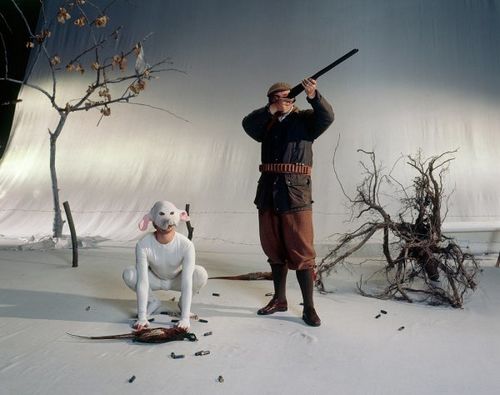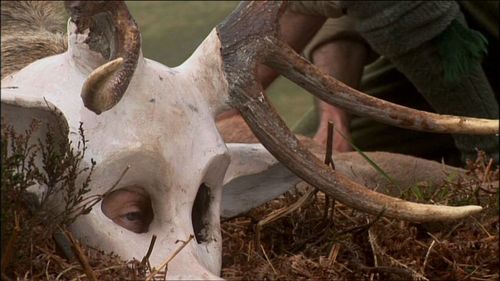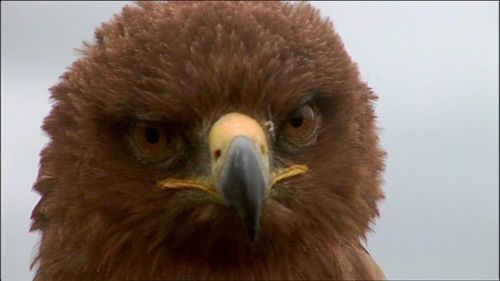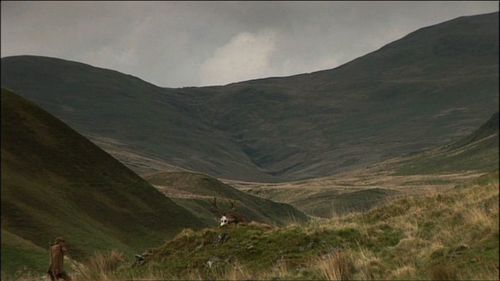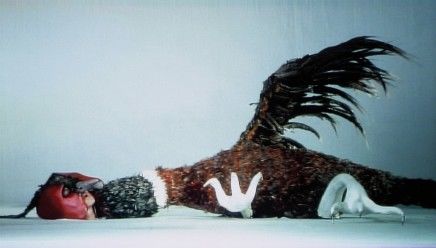
Hammer Projects: Henry Coombes
- – This is a past exhibition
Scottish artist Henry Coombes explores the tension between instinctual, natural impulses and the constraints of polite society. He presents viewers with seemingly idyllic scenarios that gradually delve into the deeper, darker inclinations of human nature. In two of his recent films—Laddy and the Lady (2005) and Gralloch (2007)—actors don animal costumes and the traditional sportsman attire of the British elite, playing out scenes at once amusing, disturbing, and surreal. Both films will be on view in the Hammer’s Video Gallery marking Coombes’ first exhibition in an American museum.

Biography
Henry Coombes was born in London in 1977 and lives in Glasgow. He studied at Central Saint Martin’s College of Art and Design as well as the Glasgow School of Art, receiving his BFA in 2002. Solo exhibitions of his work include those at Sorcha Dallas, Glasgow; Anna Helwing, Los Angeles; Susie Q Project Space, Zurich; and at Art Basel Miami Beach as part of the Positions series. His films have been screened at numerous festivals in Scotland, Germany, the Netherlands, Norway, and Canada, and he was one of six artists chosen to represent Scotland at the Venice Biennale in 2006. This is Coombes’s first solo museum exhibition.
Essay
By Carole Ann Klonarides
Sir Edwin Landseer, an artist whose work gained wide popularity among an emergent class of nouveau riche and landed aristocracy, was knighted in 1850 by Queen Victoria in recognition of his paintings and sculptures of animals associated with the hunting sport of the Scottish Highlands. The queen, after all, shared an interest in Landseer’s subject matter after her husband, Prince Albert, first leased and later purchased Balmoral, a sporting estate in Aberdeenshire, Scotland. Glasgow-based artist Henry Coombes, chosen as one of six artists to exhibit work in the Scottish Pavilion in the 2007 Venice Biennale, makes paintings, watercolors, sculptures, and videos that reframe Landseer’s nineteenth-century depictions of the hunting lifestyle as a darkened, apocalyptic vision of the privileged class’s bloodthirst for Scotland’s land and game, perhaps revealing that art, like territory and culture, is also co-opted by social forces.
Following the royal family’s lead, the upper strata of the British elite adopted the Highlands as their outdoor playground. The region’s original Gaelic culture and agrarian peasant economy were supplanted by leisure hunting estates and deer forests whose game management and ownership was (and still is) in the hands of those foreign to the region, whose principal interest and motivation for holding land was the social status it afforded together with the private enjoyment of hunting. Scotland did not adapt well to the hegemony of the hunting estate, as it was the Gaelic belief that access to game and land was a god-given right of the indigenous people.
Coombes’s five-minute looped film Gralloch (2007) is a metaphor for the complacency of the powerful in the political and social conquests of land and culture. (The title comes from the Gaelic grealach, meaning the entrails of a dead deer.) It begins with a shot of an idyllic landscape in Scotland; the only incongruity is an abandoned stag carcass, the body intact but the head a skull and antlers. A hunter enters the frame and prepares for the task of “gralloching,” or disemboweling, the stag and then incises the body cavity, which makes a hissing sound as air is released and the viscera are pulled out. During this act what appear to be living human eyes peer at us from within the skull, then close upon its completion, as if in surrender or death. In the distance a trained hunting falcon approaches from above, but paradoxically the prey already found by the hunter looks clean and bloodless.1 By the time the falcon lands, the hunter is gone, having left the innards displayed alongside the corpse, as if carrion for the bird. As the falcon picks and prods at the organs, the eyes in the skull open again, this time in terror, and it appears that for a moment there is recognition between the two of the moral and physical barbarity of the hunter and his trained accomplice. The bird, having scavenged little, takes flight, leaving the rest to rot or be eaten by another predator.
For the Victorian upper crust, taking the land and game was obviously not enough, as they made it their prerogative to co-opt the Gaelic traditions as well, recasting them into a new cultural genre through a rearticulation of what was deemed “Scottish.” This cultural cannibalization resulted in tartanry, the designing of special tweeds in emulation of the Highlanders’ tartans, to be worn by the gentry and their staff, which are an anachronism to this day. The literal evisceration of the carcass in the video becomes a parable about the “gutting” of culture in the current political climate.
In Laddy and the Lady (2005), a twelve-minute film that Coombes wrote and directed, the hard, corporeal world of blood sport is intensified by the iniquity and competitiveness of class hierarchies. Here the prey goes from beast to fowl, as two hunters—one male (and, judging from his accent, presumably of peasant stock) and the other an aristocratic woman of Scottish landed gentry (the “Lady”)—wait with their dogs (played by actors in dog costumes) as men beat the bushes to drive out pheasants or grouse for the sport of shooting. Laddy, the lady’s golden retriever, is not good at taking commands and mirrors his mistress’s anxious and abusive behavior by being equally badly behaved and high-strung. The calm and respectful demeanor of Quentin (the other hunter) and his obedient spaniel, Jack, contrasts with the cycle of abuse and servitude between Laddy and the Lady. But one should not forget that, even with restraints, Laddy has been privileged since birth with creature comforts and rewards, having been born with a pedigree. In a flashback that presumably takes place in the mistress’s manor, Laddy the pup greedily and audibly suckles his mother’s teat—it is a Matthew Barneyesque moment, highly art-directed, with milk gushing everywhere.2 Returning to the now, and despite his ill treatment from the Lady, Laddy does succeed in retrieving the shot bird before Jack and is affectionately rewarded. The only true attempt at pathos is the wounded and dying pheasant (a play on peasant?), also played by a man in a costume, which suggests the moral dimension of a Landseer painting but without the sentimentality.
Unlike Gralloch, Laddy and the Lady was shot not on location but on a sound stage, using sound effects and a bare-bones theatrical set to create the mise-en-scène of the Scottish moors. In these constructed scenes of this antiquated aristocratic sport, Coombes is perhaps working out his own ambivalent identification with trained animals: like the fancy, pedigreed, and yet subordinate hunting dogs, the artist is seen at once as part of the cultural elite and as its servant. Comparable to filmmaker Lars von Trier’s minimal set in Dogville (2003), Coombes’s stripped-down approach sets up the narrative as parabolic and, in my reading, creates a farcical social commentary that delivers an antimoral punch: the power of the privileged is predetermined, regardless of the price paid or sacrifice made. Nature, culture, and class power are still, and always will be, intertwined. Coombes’s work posits that the perceived elite nature of the leisure class, which includes the artist, is a never-ending conundrum.
Notes
1. Hunters use a trained falcon (or hawk) much like a dog, for the purpose of seeking (hunting) and driving out (flushing) game, but in this instance the falconry is not necessary, and perhaps the gralloch was left for other purposes: it is organic and biodegradable and can be a very valuable food for other animals and buzzards.
2. Au hasard Balthazar (1966), Robert Bresson’s film about class and social injustice, also has a scene of a young foal at the teat of its mother, its bucolic pleasure short-lived. Balthazar, a beast of burden, suffers servitude and cruelty under a succession of owners but accepts his fate nobly in this parable about the sins of man.
Carole Ann Klonarides is an independent curator and teacher based in Los Angeles. Recently she served as a consultant for a project involving the Long Beach Museum of Art Video Collection, which was acquired by the Getty Research Institute. [For background information on the history of hunting estates in Scotland, I am indebted to Andy Wightman, Hunting and Hegemony in the Highlands of Scotland: A Study in the Ideology of Landscapes and Landownership, Noragric Working Paper no. 36 (Ås: Noragric, Agricultural University of Norway, 2004).
This Hammer Project was organized by James Elaine, and was made possible with support from The Horace W. Goldsmith Foundation, The Annenberg Foundation, the Los Angeles County Arts Commission, and members of the Hammer Circle. Additional support has also been provided by the British Council.



